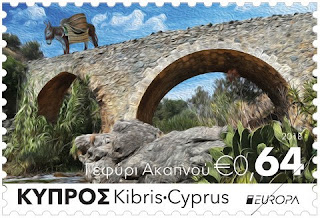 Cyprus
Cyprus
Date of Issue: 9th May 2025
two stamps se-tenant (2x 0.64 €)
both stamps are issued in a mini sheet of 8 stamps (4 of each)
both stamps are also issued in one booklet of 8 stamps (4 of each) - stamps from the booklet aren't perforated on one side
Mosaic Floor Depicting a Hippodrome Scene
The mosaic floor depicting a hippodrome scene was discovered during excavations conducted by the Department of Antiquities of Cyprus near the community of Akaki, Nicosia District. It is part of the floor decoration of a rural villa dating to the 4th century AD, which was excavated between 2023 and 2024.
The mosaic floor, measuring twenty-six meters in length, illustrates a chariot race unfolding within a hippodrome, which is rendered with great detail. The euripus or spina is clearly depicted, featuring various shrines, columns, obelisks, and sculptures that were used for timekeeping and lap counting during the race.
Four tethrippon (four-horse chariots) participate in the race, shown in four different phases of the competition. Each chariot is accompanied by two names written in Greek: the name of the charioteer and the name of one of the horses, allowing to follow the progression of the race.
The newly discovered mosaic from Akaki is unique in Cyprus and stands out for its exceptional craftsmanship but also because it provides a rare iconographic representation of chariot race during the Roman period.











































